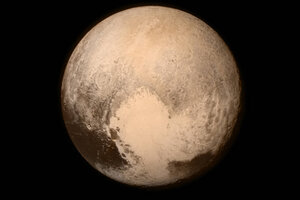Applause from 3 billion miles away as NASA waits for New Horizons to phone home
The New Horizons spacecraft cemented its place in space-exploration history Tuesday – scientists think. The first hard evidence that the craft survived its flyby of Pluto won't come until shortly after 9 p.m.

Pluto nearly fills the frame in this image from the Long Range Reconnaissance Imager (LORRI) aboard NASA’s New Horizons spacecraft, taken on July 13 when the spacecraft was 476,000 miles (768,000 kilometers) from the surface. This is the last and most detailed image sent to Earth before the spacecraft’s closest approach to Pluto on July 14. The color image has been combined with lower-resolution color information from the Ralph instrument that was acquired earlier on July 13. This view is dominated by the large, bright feature informally named the “heart,” which measures approximately 1,000 miles (1,600 kilometers) across. The heart borders darker equatorial terrains, and the mottled terrain to its east (right) are complex. However, even at this resolution, much of the heart’s interior appears remarkably featureless – possibly a sign of ongoing geologic processes.
NASA/APL/SwRI
Laurel, Md.
The New Horizons spacecraft cemented its place in space-exploration history Tuesday, flitting past Pluto – a dwarf planet with a big heart – and its largest moon Charon in what the mission's lead scientist, Alan Stern, terms "the anchor leg of the initial reconnaissance of the solar system."
Tuesday's historic flyby comes 50 years to the day after Mariner 4 performed NASA's first flyby of Mars, in 1965.
At the moment New Horizons was expected to make its closest approach, some 3 billion miles away an overflow crowd packed into an auditorium and an adjoining tent at the The Johns Hopkins University's Applied Physics Laboratory erupted in applause.
Nearly 1,000 people has gathered to celebrate the achievement – people who had worked on the mission, relatives, as well as relatives of Clyde Tombaugh, the astronomer who in 1930 discovered Pluto, and Gerard Kuiper, for whom Pluto's distant birthplace, the Kuiper Belt, is named.
In a sense, the applause was at least as much about hope and expectation than about an actual achievement. The first hard evidence that the craft survived its flyby won't come until shortly after 9 p.m. Eastern Daylight Time tonight, when it phones home for the first time since late Monday night.
The craft – the size of a baby grand piano and topped with a dish antenna for communicating with the ground – stopped communications at 11:17 EDT Monday night, as planned, to focus on gathering data.
After that, "there was absolutely nothing anyone on the operations team could do but to trust that we had prepared it well to set off on its journey on its own and do what it needed to do," said Alice Bowman, the mission's operations manager.
"I am feeling a little bit nervous," she acknowledged during a post-flyby briefing Tuesday morning. But she added that she has absolute confidence that the craft will perform as designed and that at the appropriate time, it will turn its antenna toward Earth and phone home.
Some two hours before closest-approach time, the science team rose in a standing ovation of its own as researchers got their first glimpse of the final pre-flyby image of Pluto, which arrived overnight – with the planet's heart-shaped region, seen in previous images but with less detail, in full view.
Based on a quick look at the image, the team sees a history of impacts, Dr. Stern said. Researchers also see a history of surface activity that could point to something akin to Earth's plate tectonics. This would indicate that Pluto had – and still may have – an active interior.
But a detailed interpretation awaits the details, including color data, captured during closest approach, he says.
Pluto and Charon actually form a binary planet system, and new images of Charon show that the two objects display strikingly different features. The first evidence of those differences emerged from images of the two taken from Earth.
With New Horizons, "now we can see how dramatically different they are," Stern said.
In addition to a mysterious dark patch at Charon's north pole, its surface appears to host craters and deep chasms.
Pluto appears to host a younger surface, while Charon's is an older, more battered surface, he explained. Using crater counts, the team hopes to provide relative ages for different surfaces on each object.
As for Pluto's younger looking "skin," signs of an old surface either could mean that Pluto still has an internal source of heat that can drive fresh material from depth up to repave the surface. Or weather-related processes could mask evidence of older surfaces.
[Editor's note: This article has been updated to clarify the significance of Tuesday's flyby as it compares with that of Mars.]

